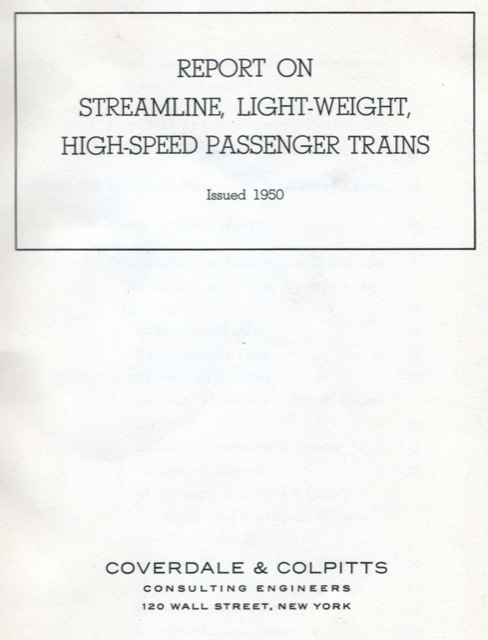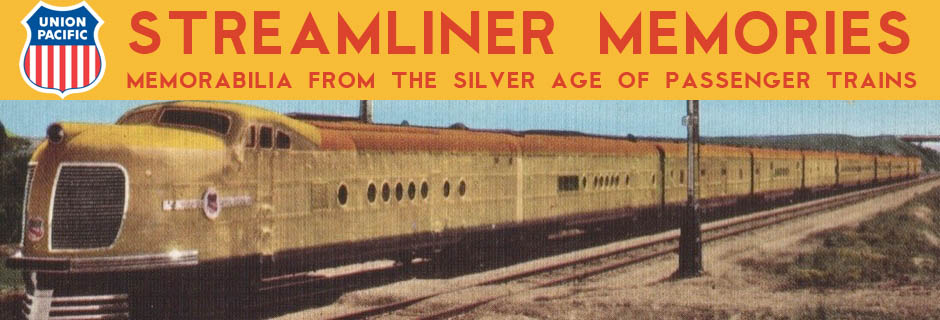I recently scanned a library copy of of the 1950 update to the 1938 Report on Streamline Trains. The report is something of a disappointment, mainly because most railroads had stopped keeping track of (or at least releasing) data for individual trains, so the report only includes data for 66 of the 260 streamlined trains operating in 1949.

Click image to download an 8.6-MB PDF of this 89-page report.
We can no longer compare, for example, the Denver Zephyr with the City of Denver, as neither train is in the report. While the Twin Zephyrs and Twin Cities Hiawathas are both in the report, the C&NW 400 is not.
In addition, you would think that after collecting more than a decade’s worth of data on streamlined trains, the people preparing the study would be able to offer a more detailed analysis of the benefits of such trains over “standard” trains. While the report offers some anecdotes–such as Southern Pacific surveys finding that half the riders of its Coast Daylight and Shasta Daylight wouldn’t take the train if fast, streamlined trains were not available–it doesn’t have any in-depth analysis.
For example, how did streamlined train ridership compare with standard trains? Ridership declined after the war; did streamlined train ridership decline less than or as much (or even more) as standard trains? When streamlined trains led to increased ridership, what accounted most for those increases: reduced travel times; more comfortable rides; or the publicity gained from having flashy trains? Since some railroads speeded up their trains without streamlining them and others streamlined their trains without speeding them up, it should have been possible to answer such questions, but the report makes no effort to do so.
The report observes that overall passenger ridership had declined by nearly two thirds from the war years through 1949. But it optimistically speculated about a time “when traffic again builds up to that of 1947.” That never happened; by 1958, intercity rail passenger miles would be half of 1947 levels; by 1970, the year before Amtrak, they would fall another two-thirds.
Instead of commenting on the decline, the report takes the positive view that ridership in 1949 was still about 50 percent greater than it had been just before the war. Yet the rapid post-war decline was critical to the future of passenger trains. Even if, as the report maintained (without more than anecdotal evidence) “the streamline train has been instrumental in holding to the rails traffic that otherwise would have been lost to” competing modes, a railroad’s decision to invest in new trains required more than a one-time boost in ridership. If that boost could not be sustained for the 15- to 20-year life of the equipment, the revenues from the trains might never pay back the investment.
For the trains for which data were available, the report carefully accounts for revenues and most operating costs. But it made no attempt to account for depreciation, interest on the capital investments, or increased costs of maintaining roadbeds to support faster trains.
Despite the upbeat tone, a railroad executive reviewing this report would have to be disturbed by the fact that, for most trains for which data were presented, 1949 ridership (measured in passenger miles per train mile) was typically 10 and as much as 20 percent lower than 1948. Most of the Rock Island Rockets had lost 10 percent; the Missouri Pacific Eagles lost 15 percent; the Southern Pacific Coast Daylights lost 12 percent and the Sunbeam, Lark, and San Joaquin Daylight even more. Only the Milwaukee Hiawathas seemed to be holding their own.
In 1950, the nation’s railroads were rapidly converting from steam to Diesel locomotives, a transition that most of them would complete well before 1960. Yet the vast majority of passenger trains were still heavyweights in 1950–260 streamlined trains must have been well under 10 percent of the total number of daily trains operating in the country. Even as late as 1970, lightweights still made up a minority of passenger cars in revenue service. Given the dismal decline in ridership, it is no wonder that railroads didn’t convert heavyweights to lightweights as swiftly as they converted steam to Diesel.
